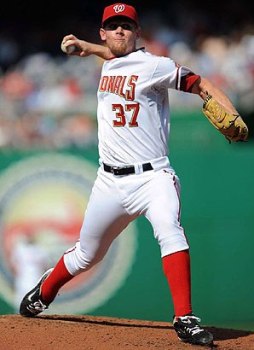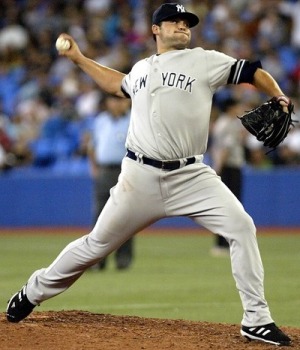Whenever my pitchers start consistently missing high in the strike zone or missing high and to the Pitching Arm Side, the first thing that I suspect is that they are Rushing toward the plate.
When I first tried to deal with the problem of Rushing, I assumed that the problem was that my pitchers weren't finishing their pitches. As a result, I followed the conventional wisdom and had them make sure that they finished forward and down.
However, that didn't help.
The reason why that didn't help is because, at the most basic level, Rushing is a Timing flaw, and a problem that crops up much earlier on in the delivery, not a problem with how the pitcher finishes their pitches.
Rushing 101
Pitching coaches and their pupils have long discussed and dealt with timing problems. In the pitching vernacular, Timing problems generally fall under the umbrella of "rushing."
When rushing, the pitching arm is late; the Pitching Arm Side (PAS) forearm isn't in the correct position at the moment the front, or Glove Side (GS), heel plants and the shoulders start rotating.

Tommy Hunter

Stephen Strasburg
In the photos above, notice how the heels of these pitchers' front feet have planted but their pitching arm side forearms, instead of being close to vertical, are much closer to horizontal. Instead of being at 90 degrees of external rotation, their PAS upper arms are at just 10 or so degrees of external rotation.
It has long been recognized that rushing can have negative performance implications. However, over the past ten to fifteen years some pitching instructors -- and Paul Nyman in particular -- seem to have realized that rushing, despite the problems it may cause, may also allow a pitcher to throw the ball harder than they can when using more conventional mechanics. That is because rushing can more effectively load the muscles of the shoulder and torso and increase their power output.[1]
Rushing in Detail
To understand what happens, and why, when a pitcher Rushes, you have to understand the timing of a typical pitcher. When it comes to most proficient pitchers, their shoulders start to turn either at, or immediately after, the moment that their Glove Side (or GS) foot lands on the ground. This happens pretty much reflexively; the GS foot lands and the shoulders start to rotate. In the case of a pitcher whose mechanics and timing are on, at the moment their shoulders start
to rotate their Pitching Arm Side (or PAS) elbow will be at the level of their shoulders and their PAS upper arm will be at 90 degrees of external rotation.
If a pitcher rushes to the plate, and by that I mean that he moves his lower body forward relatively faster than he usually does, then at the moment that his GS foot lands on the ground and his shoulders start to rotate, his PAS upper arm will not be at 90 degrees of external rotation. Instead, their PAS forearm will still be on its way up. This can cause a variety of problems, including leaving the ball up in the strike zone.
In many cases, Rushing can be caused by a pitcher trying to get something extra on the ball by striding especially forcefully toward the plate. The problem is that the stride toward the plate isn't the real source of a pitcher's power; instead, the properly timed and sequenced rotation of the hips, torso, and shoulders is. By trying to stride especially powerfully toward the plate when throwing a particular pitch, pitchers are far more likely to mess up their timing, and possibly even cost themselves velocity as a result, than they are to increase their velocity.
Rushing and Timing
Let me explain this is greater detail for those of you who, like me, have to really understand something before you can fix it. Assume a pitcher normally takes .75 seconds from lifting their glove-side foot to planting their glove-side foot (at which point they start turning their shoulders). Also assume that they normally break their hands .5 seconds after lifting their glove-side foot and then take .25 seconds to get their pitching arm up to the high cocked position. Now assume that the pitcher rushes (their lower body) in order to get a little bit extra on the ball. As a result, they speed up their lower body such that it only takes them .7 (not the normal .75) seconds from lifting their glove-side foot to planting their glove-side foot (at which point they start turning their shoulders). If they stick to their standard upper body rhythm, where they break their hands .5 seconds after lifting their glove-side foot and then take .25
seconds to get their pitching arm up to the high cocked position, then at the moment that their glove side foot lands, then their pitching arm side forearm will not be vertical at the moment that their glove-side foot lands. Instead, it will still be on the way up to vertical (.05 seconds short of vertical, to be precise). As a result, the arm will bounce (or lay back) differently and the ball will be released from a slightly different point. Since pitching is timing, that small timing difference is often enough to mess up a pitcher's timing and cause a pitch to be a ball rather than a strike. If you are having a hard time imagining when or why this timing difference could occur, consider a pitcher who switches from a standard delivery from the Set position (e.g. with a leg lift) to using a slide step. Eliminating the leg lift will allow them to plant their GS foot faster, which can cause problems if their PAS forearm isn't up and in the Ready position when their shoulders start to rotate.
What Rushing Looks Like
I have a number of pictures in my library that illustrate what Rushing looks like.

Jeremy Hellickson

Joba Chamberlain
In each case, the thing to notice is how the pitcher's Glove Side (GS) foot is planted, and their shoulders are likely starting to rotate, but their Pitching Arm Side (PAS) forearm is horizontal rather than vertical.
Fixing Rushing
In my experience, problems with rushing often arise when a pitcher tries to turn their velocity up to "11" by speeding up their body but doesn't also speed up their arm action (e.g. when and/or where they break their hands). As a result, to fix the problem of rushing you have to get the pitcher's timing back in sync. There are a number of things that I do to achieve this goal.
In general, when I sense that my pitchers are rushing during a game, I emphasize that they need to be steady and smooth when moving to the plate rather than jumping toward the plate. When they are getting ready to pitch, I will call out to them "Nice and smooth" which usually reminds them to not move too quickly toward the
plate. If that doesn't work, then I tell that they should only try to throw 90% (rather than 110%).
That makes the point that there are actually two types of rushing: occasional and habitual.
When someone is occasionally rushing (e.g. sometimes missing high), then their timing is only occasionally different (usually when they are throwing hard). As a result, the
fix is to emphasize that they need to make their timing more consistent. That means they need to not jump forward when throwing some pitches (and not others).
When someone is habitually rushing (e.g. always missing high), then their timing is fundamentally flawed. As a result, you need to consider changing their mechanics so that their arm is up and ready at the moment that their shoulders start to rotate. One way to do this is to have them break their hands sooner.